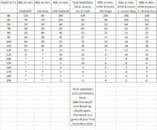This is a funny thread. I say this because of all the threads on how tables no longer need to be taught, or needed. Reading the OP the first I thought was avg depth 70' & 46 minutes (70+46=116) and a already somewhat consevative 120 rule. I thought at most they may have exceeded NDL by a minute or so and how the deco times just didn't fit the situation.
This is what happens when tables are no longer taught. One must be able to trust the computer and you cant do that if you don't know if the computer is lying or not. If you don't understand the table basics along with a few memorized rules to verify correct data, then you should not trust the computer further than a data recorder. They did the same dive before and all was well. At least they recognized something was not right. What would have happened if the computer would have been aggressive instead of over conservative and the diver was afraid to come up because of the deco being called for, and then skipped the deco and came up. I have to agree with some posters ., Get a set of tables and plan with them. I doubt any one will have an issue with teaching them to any one. To the OP. get a table and look at the relation ship of (depth) plus (time at depth) for NDL's for various depths along with the deco required for crossing the line by a couple of minutes. You will find tha most sums is 110-120 and that the deco for crossing is just a couple of minutes total. As a note when you do cross unknowing ly that the optional safety stop now becomes a mandatory one and should cover the deco requirement.
One other thing that bothers me is that on prior dives you said that with the medium setting your bottom time was cut in half. Do you dive till a 2 minute warning goes off. It would seem that if you dove it before that you would have been curious why the dive is lasting so long if the old setting gave a NLD bottom time of 23 minutes. Why did you dive till 46 minutes? And what would have happened if your alarm did not go off to tell you to go up short on air in a real need of deco. This hits on plan the dive and dive the plan.




